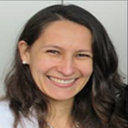[Double aortic arch: incidental cerebral angiography finding in an adult patient with headache--embrionary cardiovascular morphogenic pattern review].
Keywords
Abstract
BACKGROUND
Cerebral angiography is a technique used to detect cerebral vessel anomalies. It is critical that a neuroradiologist is familiar with the normal anatomic development and its anomalies as, during an angiography, they may influence the way the procedure is done.
METHODS
Regarding an incidental finding of a double aortic arch during a cerebral angiography in an adult patient, the authors proceeded to a bibliographic review of the normal embriogenic cardiovascular morphogenesis patterns and its anomalies.
CONCLUSIONS
The existence of a double aortic arch constitutes an embrionary pattern typical at six weeks of gestation that results from the process of progression/regression of the six pairs of pharyngeal arches; usually the double aortic arch regresses during the seventh week of gestation. When the fourth right pharyngeal arch and the right dorsal aorta do not regress, this double aortic pattern persists after birth. There are several symptoms related to this anomaly but in some rare cases, like the one presented, they might be absent and are only identified accidentally.
CONCLUSIONS
Studying the pattern of cardiovascular morphogenesis and its anomalies helps the neuroradiologist performing a cerebral angiogram.



